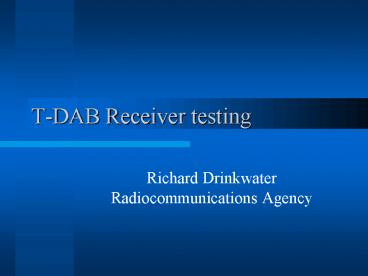T-DAB Receiver testing - PowerPoint PPT Presentation
1 / 18
Title:
T-DAB Receiver testing
Description:
... carrying 6 quality audio stereo programmes in 1.5MHz ... Portable stereo unit with rod antenna. DAB #4. Miniature personal receiver using rod antenna ... – PowerPoint PPT presentation
Number of Views:39
Avg rating:3.0/5.0
Title: T-DAB Receiver testing
1
T-DAB Receiver testing
- Richard Drinkwater Radiocommunications Agency
2
Introduction
- Complaints received from DAB listeners about poor
reception - Is this due to poor service coverage or poorly
performing receivers? - Receiver tests performed to establish the
sensitivity of a selection of current domestic
receivers
3
Technology
- DAB technology
- Benefits
- More rugged transmission format
- Much less spectrum usage capable of carrying 6
quality audio stereo programmes in 1.5MHz against
2.2MHz per programme for complete mainland UK FM
coverage - Drawbacks
- More complicated ( expensive) receivers for the
listeners
4
UK Spectrum Occupancy FM v DAB
5
BS 502482001 test criteria
- BS EN 502482001, Characteristics of DAB
receivers - Minimum power of -81dB(mW) for a BER of 10-4 at
the convolutional decoder output of the receiver
(VHF and L-band)
6
Methodology
- Objective tests were not possible without
connections to internal circuitry - Subjective tests were performed which established
the minimum field-strength at which audio
impairments (more than 1 click in 5 seconds) were
heard
7
Test set-up
Measuring voltage V and height X enables a known
field strength (V/m) to be established at the
receiver under test
8
GTEM! cell
9
Results on channel 12D (229.075 MHz)
UEP protection Bit rate kb/s Sampling rate kb/s DAB Rx 1 DAB Rx 2 DAB Rx 3 DAB Rx 4
3 48 24 44.74 31.15 44.80 41.74
3 64 24 43.74 30.15 39.80 41.74
3 96 48 45.74 31.15 46.80 40.74
3 112 48 45.74 32.15 48.80 41.74
3 128 48 44.74 31.15 44.80 42.74
3 160 48 45.74 31.15 46.80 41.74
3 192 48 45.74 33.15 44.80 42.74
10
graphically
11
which means
- For a field strength of 45dBµV/m, the receiver
input power at 222MHz would be-77dBm if the
receiver had a 50O input impedance, and a dipole
antenna - Tested receivers did not, and the standard is
written in antenna port power terms, so it is
impossible to equate the tests with the standard
12
Receivers tested
- DAB 1
- Miniature personal receiver using earphone lead
as antenna - DAB 2
- Portable receiver with rod antenna
- DAB 3
- Portable stereo unit with rod antenna
- DAB 4
- Miniature personal receiver using rod antenna
13
Service planning criteria
- National DAB services
- Edge of service area is considered to be when
field strength is 58dB(µV/m) at 10m above ground
level for 99 locations, 99 of the time - Field strength at 1.5m agl is very approximately
10dB lower than at 10m agl in open terrain - In a single frequency network, other transmitters
within about 70km (246us) add to the signal
available to the receiver
14
Portable equipment
- Inefficient antennas
- Low antenna height
- Body shielding
- Building shielding and reflections
- Shielding attenuates the signal
- Local reflections tend to add to the signal
received
15
Analysis of test method
- Strengths
- Straightforward, repeatable method using GTEM!
cell - Weaknesses
- Subjective assessment
- No multipath reception distortion
- Incomparable with BS test method
16
Some thoughts
- Assuming a field strength at the edge of the
service area of approximately 48dBµV/m at 1.5m
agl, it would appear that the tested receivers
would work in free space conditions. Due to
shielding effects there is probably inadequate
margin in sensitivity (in 3 out of the 4 tested
receivers) for satisfactory reception under
everyday usage conditions.
17
Possible solutions
- Very low power fill in transmitters
- Relatively inexpensive solution
- No international clearance required
- Improve receiver antenna performance
- Particularly the match to input circuitry
18
Contacts
- richard.drinkwater_at_ra.gsi.gov.uk
- richard.drinkwater_at_ofcom.org.uk
- RTCG
- Radiocommunications Agency
- Whyteleafe Hill
- Whyteleafe
- Surrey
- CR3 0YY 44 (0)20 8655 8300































